Entrepreneurship: Historical Development and Indian Scenario Analysis
VerifiedAdded on 2021/07/05
|41
|13709
|130
Report
AI Summary
This report provides a comprehensive introduction to entrepreneurship, tracing its historical development from the 12th century to the present day. It examines the evolution of the term, from its initial use as a 'go-between' to its modern economic significance. The report highlights key figures like Richard Cantillon and Joseph Schumpeter, who shaped the understanding of entrepreneurship. A significant portion of the report focuses on the current scenario of entrepreneurship in India, discussing the growth of the MSME sector, government initiatives, and the potential for future economic development. The report analyzes the 'Future Entrepreneurial Readiness Index' for various Indian states, providing insights into the factors that contribute to a favorable entrepreneurial environment. The report also defines the concepts of entrepreneur and entrepreneurship, and discusses the role of ethics and social responsibility for entrepreneurs. Overall, the report offers a detailed overview of entrepreneurship, its historical context, and its relevance in the Indian economy.

See discussions, stats, and author profiles for this publication at: https://www.researchgate.net/publication/301659818
Introduction to Entrepreneurship
Chapter · March 2015
CITATIONS
3
READS
385,412
1 author:
Some of the authors of this publication are also working on these related projects:
Impact of SHGs on Social, Economic and Political Empowerment of Women: A Case of Ghaziabad DistrictView project
Dr. Anurag Pahuja
49PUBLICATIONS88CITATIONS
SEE PROFILE
All content following this page was uploaded by Dr. Anurag Pahuja on 27 April 2016.
The user has requested enhancement of the downloaded file.
Introduction to Entrepreneurship
Chapter · March 2015
CITATIONS
3
READS
385,412
1 author:
Some of the authors of this publication are also working on these related projects:
Impact of SHGs on Social, Economic and Political Empowerment of Women: A Case of Ghaziabad DistrictView project
Dr. Anurag Pahuja
49PUBLICATIONS88CITATIONS
SEE PROFILE
All content following this page was uploaded by Dr. Anurag Pahuja on 27 April 2016.
The user has requested enhancement of the downloaded file.
Paraphrase This Document
Need a fresh take? Get an instant paraphrase of this document with our AI Paraphraser
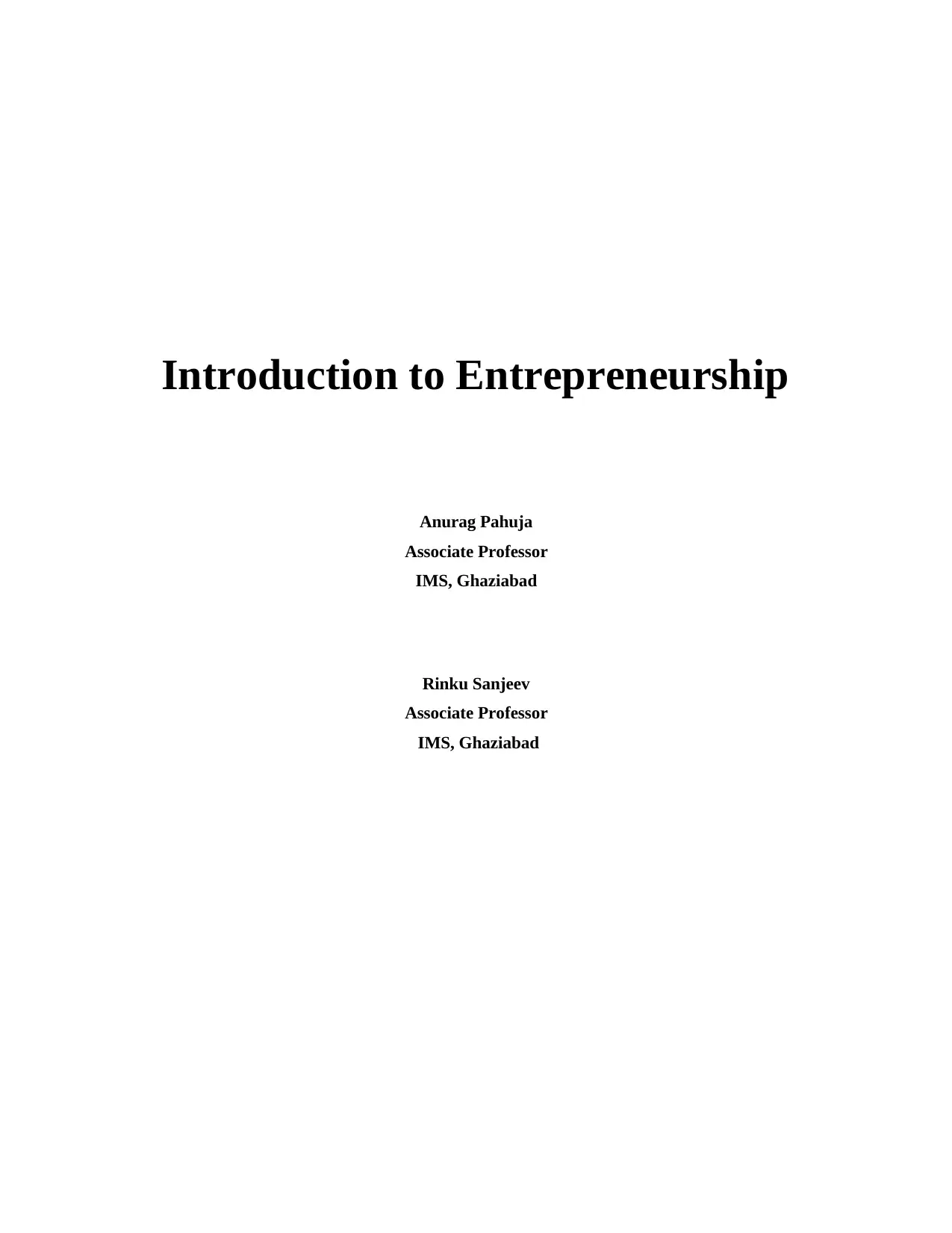
Introduction to Entrepreneurship
Anurag Pahuja
Associate Professor
IMS, Ghaziabad
Rinku Sanjeev
Associate Professor
IMS, Ghaziabad
Anurag Pahuja
Associate Professor
IMS, Ghaziabad
Rinku Sanjeev
Associate Professor
IMS, Ghaziabad
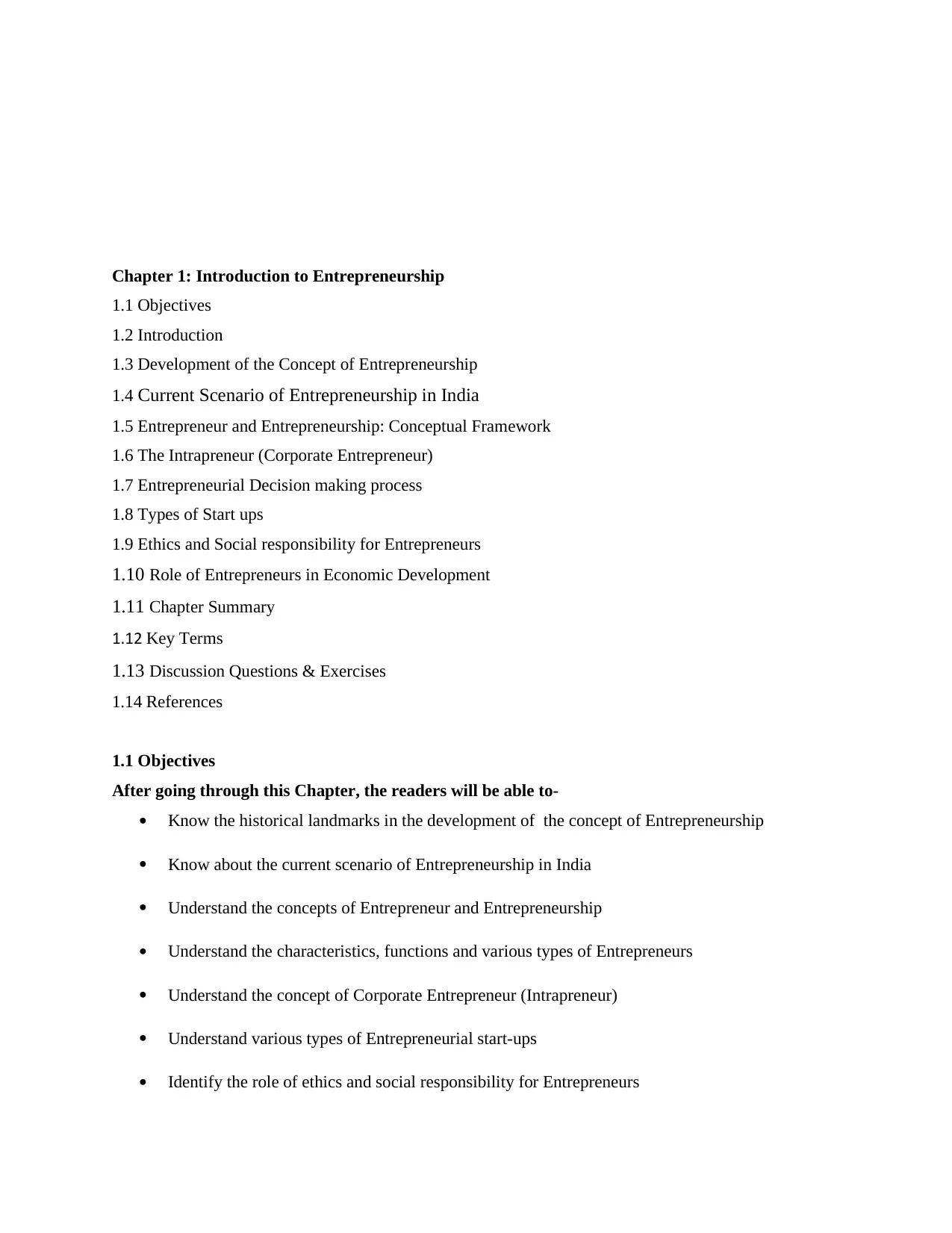
Chapter 1: Introduction to Entrepreneurship
1.1 Objectives
1.2 Introduction
1.3 Development of the Concept of Entrepreneurship
1.4 Current Scenario of Entrepreneurship in India
1.5 Entrepreneur and Entrepreneurship: Conceptual Framework
1.6 The Intrapreneur (Corporate Entrepreneur)
1.7 Entrepreneurial Decision making process
1.8 Types of Start ups
1.9 Ethics and Social responsibility for Entrepreneurs
1.10 Role of Entrepreneurs in Economic Development
1.11 Chapter Summary
1.12 Key Terms
1.13 Discussion Questions & Exercises
1.14 References
1.1 Objectives
After going through this Chapter, the readers will be able to-
Know the historical landmarks in the development of the concept of Entrepreneurship
Know about the current scenario of Entrepreneurship in India
Understand the concepts of Entrepreneur and Entrepreneurship
Understand the characteristics, functions and various types of Entrepreneurs
Understand the concept of Corporate Entrepreneur (Intrapreneur)
Understand various types of Entrepreneurial start-ups
Identify the role of ethics and social responsibility for Entrepreneurs
1.1 Objectives
1.2 Introduction
1.3 Development of the Concept of Entrepreneurship
1.4 Current Scenario of Entrepreneurship in India
1.5 Entrepreneur and Entrepreneurship: Conceptual Framework
1.6 The Intrapreneur (Corporate Entrepreneur)
1.7 Entrepreneurial Decision making process
1.8 Types of Start ups
1.9 Ethics and Social responsibility for Entrepreneurs
1.10 Role of Entrepreneurs in Economic Development
1.11 Chapter Summary
1.12 Key Terms
1.13 Discussion Questions & Exercises
1.14 References
1.1 Objectives
After going through this Chapter, the readers will be able to-
Know the historical landmarks in the development of the concept of Entrepreneurship
Know about the current scenario of Entrepreneurship in India
Understand the concepts of Entrepreneur and Entrepreneurship
Understand the characteristics, functions and various types of Entrepreneurs
Understand the concept of Corporate Entrepreneur (Intrapreneur)
Understand various types of Entrepreneurial start-ups
Identify the role of ethics and social responsibility for Entrepreneurs
⊘ This is a preview!⊘
Do you want full access?
Subscribe today to unlock all pages.

Trusted by 1+ million students worldwide
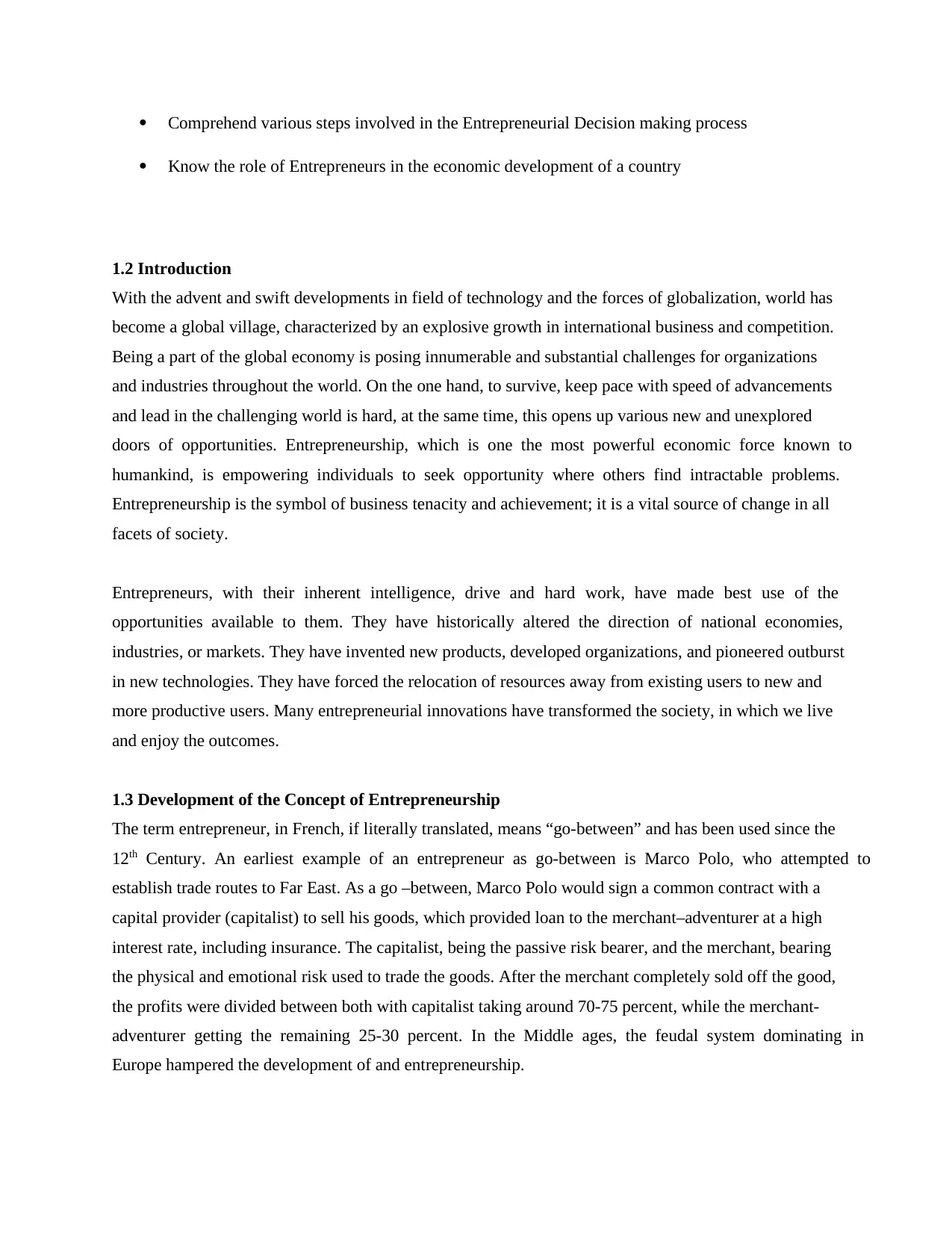
Comprehend various steps involved in the Entrepreneurial Decision making process
Know the role of Entrepreneurs in the economic development of a country
1.2 Introduction
With the advent and swift developments in field of technology and the forces of globalization, world has
become a global village, characterized by an explosive growth in international business and competition.
Being a part of the global economy is posing innumerable and substantial challenges for organizations
and industries throughout the world. On the one hand, to survive, keep pace with speed of advancements
and lead in the challenging world is hard, at the same time, this opens up various new and unexplored
doors of opportunities. Entrepreneurship, which is one the most powerful economic force known to
humankind, is empowering individuals to seek opportunity where others find intractable problems.
Entrepreneurship is the symbol of business tenacity and achievement; it is a vital source of change in all
facets of society.
Entrepreneurs, with their inherent intelligence, drive and hard work, have made best use of the
opportunities available to them. They have historically altered the direction of national economies,
industries, or markets. They have invented new products, developed organizations, and pioneered outburst
in new technologies. They have forced the relocation of resources away from existing users to new and
more productive users. Many entrepreneurial innovations have transformed the society, in which we live
and enjoy the outcomes.
1.3 Development of the Concept of Entrepreneurship
The term entrepreneur, in French, if literally translated, means “go-between” and has been used since the
12th Century. An earliest example of an entrepreneur as go-between is Marco Polo, who attempted to
establish trade routes to Far East. As a go –between, Marco Polo would sign a common contract with a
capital provider (capitalist) to sell his goods, which provided loan to the merchant–adventurer at a high
interest rate, including insurance. The capitalist, being the passive risk bearer, and the merchant, bearing
the physical and emotional risk used to trade the goods. After the merchant completely sold off the good,
the profits were divided between both with capitalist taking around 70-75 percent, while the merchant-
adventurer getting the remaining 25-30 percent. In the Middle ages, the feudal system dominating in
Europe hampered the development of and entrepreneurship.
Know the role of Entrepreneurs in the economic development of a country
1.2 Introduction
With the advent and swift developments in field of technology and the forces of globalization, world has
become a global village, characterized by an explosive growth in international business and competition.
Being a part of the global economy is posing innumerable and substantial challenges for organizations
and industries throughout the world. On the one hand, to survive, keep pace with speed of advancements
and lead in the challenging world is hard, at the same time, this opens up various new and unexplored
doors of opportunities. Entrepreneurship, which is one the most powerful economic force known to
humankind, is empowering individuals to seek opportunity where others find intractable problems.
Entrepreneurship is the symbol of business tenacity and achievement; it is a vital source of change in all
facets of society.
Entrepreneurs, with their inherent intelligence, drive and hard work, have made best use of the
opportunities available to them. They have historically altered the direction of national economies,
industries, or markets. They have invented new products, developed organizations, and pioneered outburst
in new technologies. They have forced the relocation of resources away from existing users to new and
more productive users. Many entrepreneurial innovations have transformed the society, in which we live
and enjoy the outcomes.
1.3 Development of the Concept of Entrepreneurship
The term entrepreneur, in French, if literally translated, means “go-between” and has been used since the
12th Century. An earliest example of an entrepreneur as go-between is Marco Polo, who attempted to
establish trade routes to Far East. As a go –between, Marco Polo would sign a common contract with a
capital provider (capitalist) to sell his goods, which provided loan to the merchant–adventurer at a high
interest rate, including insurance. The capitalist, being the passive risk bearer, and the merchant, bearing
the physical and emotional risk used to trade the goods. After the merchant completely sold off the good,
the profits were divided between both with capitalist taking around 70-75 percent, while the merchant-
adventurer getting the remaining 25-30 percent. In the Middle ages, the feudal system dominating in
Europe hampered the development of and entrepreneurship.
Paraphrase This Document
Need a fresh take? Get an instant paraphrase of this document with our AI Paraphraser
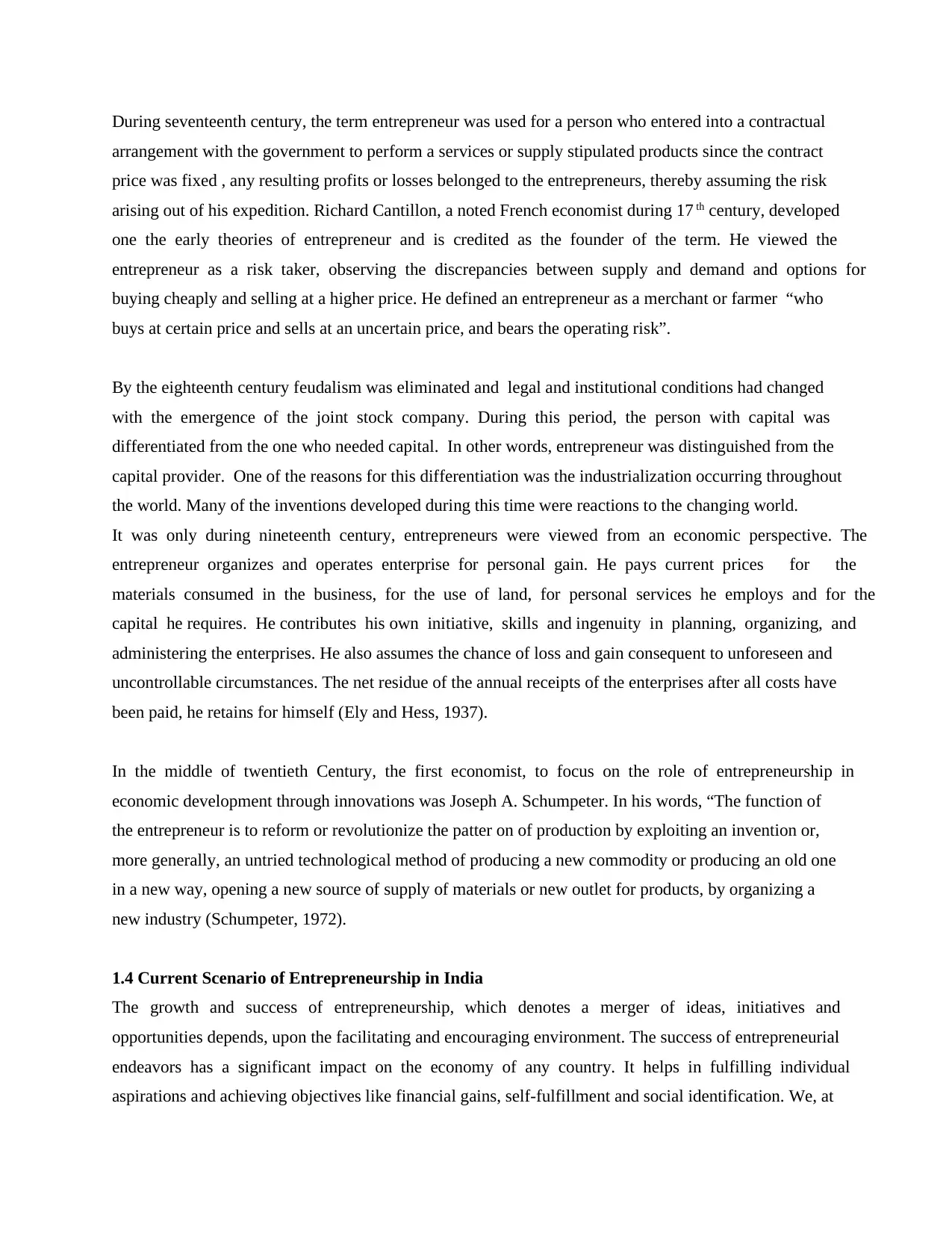
During seventeenth century, the term entrepreneur was used for a person who entered into a contractual
arrangement with the government to perform a services or supply stipulated products since the contract
price was fixed , any resulting profits or losses belonged to the entrepreneurs, thereby assuming the risk
arising out of his expedition. Richard Cantillon, a noted French economist during 17 th century, developed
one the early theories of entrepreneur and is credited as the founder of the term. He viewed the
entrepreneur as a risk taker, observing the discrepancies between supply and demand and options for
buying cheaply and selling at a higher price. He defined an entrepreneur as a merchant or farmer “who
buys at certain price and sells at an uncertain price, and bears the operating risk”.
By the eighteenth century feudalism was eliminated and legal and institutional conditions had changed
with the emergence of the joint stock company. During this period, the person with capital was
differentiated from the one who needed capital. In other words, entrepreneur was distinguished from the
capital provider. One of the reasons for this differentiation was the industrialization occurring throughout
the world. Many of the inventions developed during this time were reactions to the changing world.
It was only during nineteenth century, entrepreneurs were viewed from an economic perspective. The
entrepreneur organizes and operates enterprise for personal gain. He pays current prices for the
materials consumed in the business, for the use of land, for personal services he employs and for the
capital he requires. He contributes his own initiative, skills and ingenuity in planning, organizing, and
administering the enterprises. He also assumes the chance of loss and gain consequent to unforeseen and
uncontrollable circumstances. The net residue of the annual receipts of the enterprises after all costs have
been paid, he retains for himself (Ely and Hess, 1937).
In the middle of twentieth Century, the first economist, to focus on the role of entrepreneurship in
economic development through innovations was Joseph A. Schumpeter. In his words, “The function of
the entrepreneur is to reform or revolutionize the patter on of production by exploiting an invention or,
more generally, an untried technological method of producing a new commodity or producing an old one
in a new way, opening a new source of supply of materials or new outlet for products, by organizing a
new industry (Schumpeter, 1972).
1.4 Current Scenario of Entrepreneurship in India
The growth and success of entrepreneurship, which denotes a merger of ideas, initiatives and
opportunities depends, upon the facilitating and encouraging environment. The success of entrepreneurial
endeavors has a significant impact on the economy of any country. It helps in fulfilling individual
aspirations and achieving objectives like financial gains, self-fulfillment and social identification. We, at
arrangement with the government to perform a services or supply stipulated products since the contract
price was fixed , any resulting profits or losses belonged to the entrepreneurs, thereby assuming the risk
arising out of his expedition. Richard Cantillon, a noted French economist during 17 th century, developed
one the early theories of entrepreneur and is credited as the founder of the term. He viewed the
entrepreneur as a risk taker, observing the discrepancies between supply and demand and options for
buying cheaply and selling at a higher price. He defined an entrepreneur as a merchant or farmer “who
buys at certain price and sells at an uncertain price, and bears the operating risk”.
By the eighteenth century feudalism was eliminated and legal and institutional conditions had changed
with the emergence of the joint stock company. During this period, the person with capital was
differentiated from the one who needed capital. In other words, entrepreneur was distinguished from the
capital provider. One of the reasons for this differentiation was the industrialization occurring throughout
the world. Many of the inventions developed during this time were reactions to the changing world.
It was only during nineteenth century, entrepreneurs were viewed from an economic perspective. The
entrepreneur organizes and operates enterprise for personal gain. He pays current prices for the
materials consumed in the business, for the use of land, for personal services he employs and for the
capital he requires. He contributes his own initiative, skills and ingenuity in planning, organizing, and
administering the enterprises. He also assumes the chance of loss and gain consequent to unforeseen and
uncontrollable circumstances. The net residue of the annual receipts of the enterprises after all costs have
been paid, he retains for himself (Ely and Hess, 1937).
In the middle of twentieth Century, the first economist, to focus on the role of entrepreneurship in
economic development through innovations was Joseph A. Schumpeter. In his words, “The function of
the entrepreneur is to reform or revolutionize the patter on of production by exploiting an invention or,
more generally, an untried technological method of producing a new commodity or producing an old one
in a new way, opening a new source of supply of materials or new outlet for products, by organizing a
new industry (Schumpeter, 1972).
1.4 Current Scenario of Entrepreneurship in India
The growth and success of entrepreneurship, which denotes a merger of ideas, initiatives and
opportunities depends, upon the facilitating and encouraging environment. The success of entrepreneurial
endeavors has a significant impact on the economy of any country. It helps in fulfilling individual
aspirations and achieving objectives like financial gains, self-fulfillment and social identification. We, at
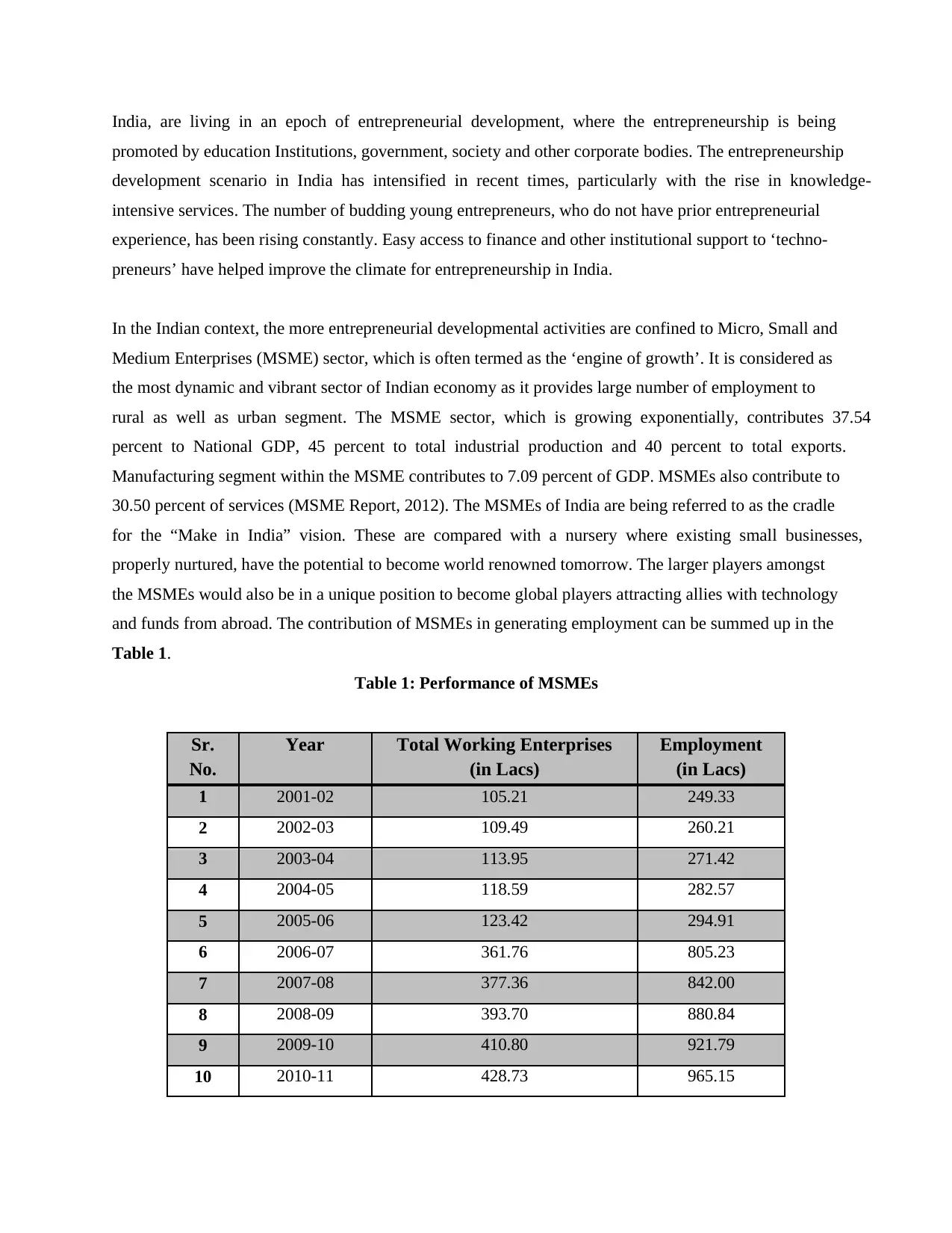
India, are living in an epoch of entrepreneurial development, where the entrepreneurship is being
promoted by education Institutions, government, society and other corporate bodies. The entrepreneurship
development scenario in India has intensified in recent times, particularly with the rise in knowledge-
intensive services. The number of budding young entrepreneurs, who do not have prior entrepreneurial
experience, has been rising constantly. Easy access to finance and other institutional support to ‘techno-
preneurs’ have helped improve the climate for entrepreneurship in India.
In the Indian context, the more entrepreneurial developmental activities are confined to Micro, Small and
Medium Enterprises (MSME) sector, which is often termed as the ‘engine of growth’. It is considered as
the most dynamic and vibrant sector of Indian economy as it provides large number of employment to
rural as well as urban segment. The MSME sector, which is growing exponentially, contributes 37.54
percent to National GDP, 45 percent to total industrial production and 40 percent to total exports.
Manufacturing segment within the MSME contributes to 7.09 percent of GDP. MSMEs also contribute to
30.50 percent of services (MSME Report, 2012). The MSMEs of India are being referred to as the cradle
for the “Make in India” vision. These are compared with a nursery where existing small businesses,
properly nurtured, have the potential to become world renowned tomorrow. The larger players amongst
the MSMEs would also be in a unique position to become global players attracting allies with technology
and funds from abroad. The contribution of MSMEs in generating employment can be summed up in the
Table 1.
Table 1: Performance of MSMEs
Sr.
No.
Year Total Working Enterprises
(in Lacs)
Employment
(in Lacs)
1 2001-02 105.21 249.33
2 2002-03 109.49 260.21
3 2003-04 113.95 271.42
4 2004-05 118.59 282.57
5 2005-06 123.42 294.91
6 2006-07 361.76 805.23
7 2007-08 377.36 842.00
8 2008-09 393.70 880.84
9 2009-10 410.80 921.79
10 2010-11 428.73 965.15
promoted by education Institutions, government, society and other corporate bodies. The entrepreneurship
development scenario in India has intensified in recent times, particularly with the rise in knowledge-
intensive services. The number of budding young entrepreneurs, who do not have prior entrepreneurial
experience, has been rising constantly. Easy access to finance and other institutional support to ‘techno-
preneurs’ have helped improve the climate for entrepreneurship in India.
In the Indian context, the more entrepreneurial developmental activities are confined to Micro, Small and
Medium Enterprises (MSME) sector, which is often termed as the ‘engine of growth’. It is considered as
the most dynamic and vibrant sector of Indian economy as it provides large number of employment to
rural as well as urban segment. The MSME sector, which is growing exponentially, contributes 37.54
percent to National GDP, 45 percent to total industrial production and 40 percent to total exports.
Manufacturing segment within the MSME contributes to 7.09 percent of GDP. MSMEs also contribute to
30.50 percent of services (MSME Report, 2012). The MSMEs of India are being referred to as the cradle
for the “Make in India” vision. These are compared with a nursery where existing small businesses,
properly nurtured, have the potential to become world renowned tomorrow. The larger players amongst
the MSMEs would also be in a unique position to become global players attracting allies with technology
and funds from abroad. The contribution of MSMEs in generating employment can be summed up in the
Table 1.
Table 1: Performance of MSMEs
Sr.
No.
Year Total Working Enterprises
(in Lacs)
Employment
(in Lacs)
1 2001-02 105.21 249.33
2 2002-03 109.49 260.21
3 2003-04 113.95 271.42
4 2004-05 118.59 282.57
5 2005-06 123.42 294.91
6 2006-07 361.76 805.23
7 2007-08 377.36 842.00
8 2008-09 393.70 880.84
9 2009-10 410.80 921.79
10 2010-11 428.73 965.15
⊘ This is a preview!⊘
Do you want full access?
Subscribe today to unlock all pages.

Trusted by 1+ million students worldwide
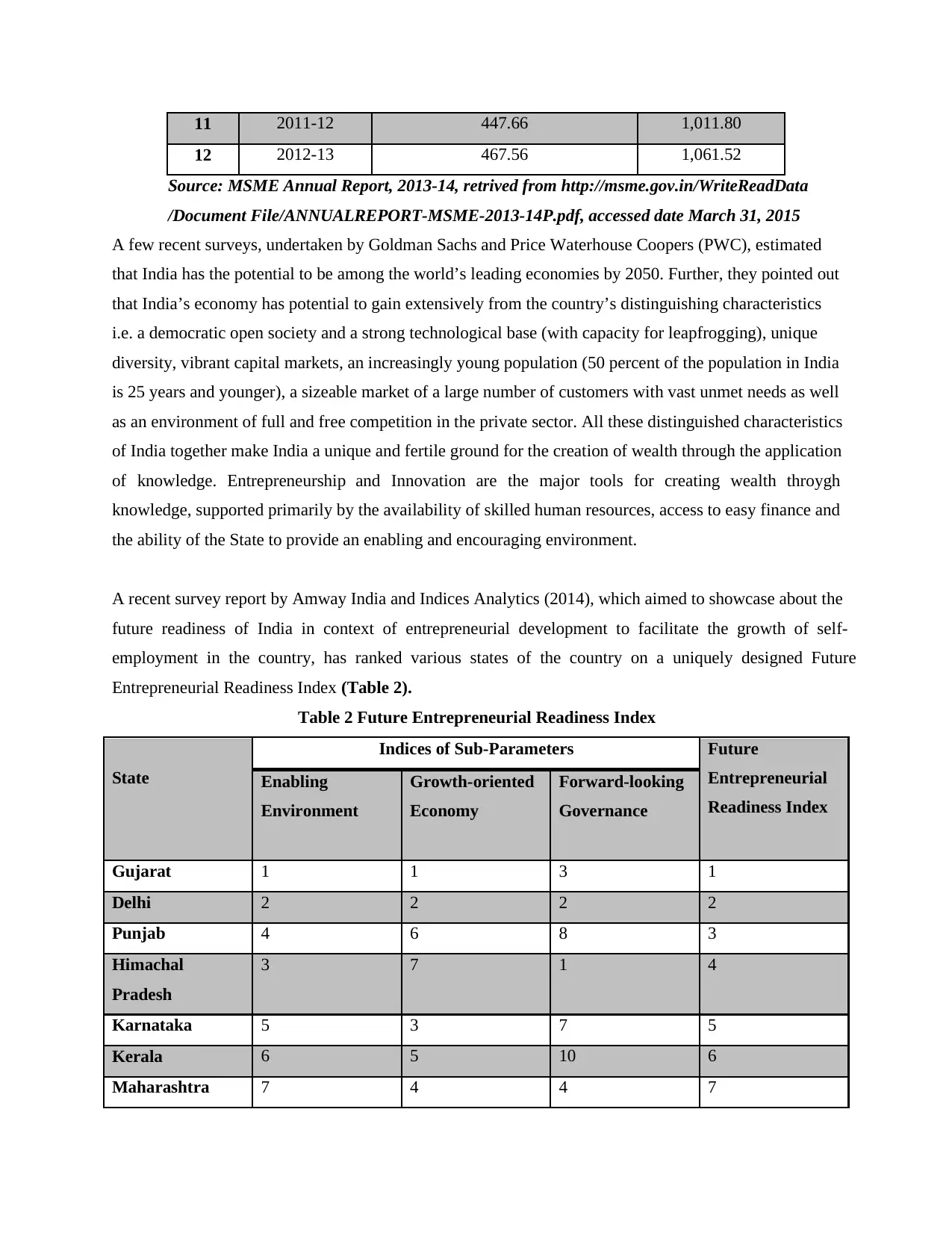
11 2011-12 447.66 1,011.80
12 2012-13 467.56 1,061.52
Source: MSME Annual Report, 2013-14, retrived from http://msme.gov.in/WriteReadData
/Document File/ANNUALREPORT-MSME-2013-14P.pdf, accessed date March 31, 2015
A few recent surveys, undertaken by Goldman Sachs and Price Waterhouse Coopers (PWC), estimated
that India has the potential to be among the world’s leading economies by 2050. Further, they pointed out
that India’s economy has potential to gain extensively from the country’s distinguishing characteristics
i.e. a democratic open society and a strong technological base (with capacity for leapfrogging), unique
diversity, vibrant capital markets, an increasingly young population (50 percent of the population in India
is 25 years and younger), a sizeable market of a large number of customers with vast unmet needs as well
as an environment of full and free competition in the private sector. All these distinguished characteristics
of India together make India a unique and fertile ground for the creation of wealth through the application
of knowledge. Entrepreneurship and Innovation are the major tools for creating wealth throygh
knowledge, supported primarily by the availability of skilled human resources, access to easy finance and
the ability of the State to provide an enabling and encouraging environment.
A recent survey report by Amway India and Indices Analytics (2014), which aimed to showcase about the
future readiness of India in context of entrepreneurial development to facilitate the growth of self-
employment in the country, has ranked various states of the country on a uniquely designed Future
Entrepreneurial Readiness Index (Table 2).
Table 2 Future Entrepreneurial Readiness Index
State
Indices of Sub-Parameters Future
Entrepreneurial
Readiness Index
Enabling
Environment
Growth-oriented
Economy
Forward-looking
Governance
Gujarat 1 1 3 1
Delhi 2 2 2 2
Punjab 4 6 8 3
Himachal
Pradesh
3 7 1 4
Karnataka 5 3 7 5
Kerala 6 5 10 6
Maharashtra 7 4 4 7
12 2012-13 467.56 1,061.52
Source: MSME Annual Report, 2013-14, retrived from http://msme.gov.in/WriteReadData
/Document File/ANNUALREPORT-MSME-2013-14P.pdf, accessed date March 31, 2015
A few recent surveys, undertaken by Goldman Sachs and Price Waterhouse Coopers (PWC), estimated
that India has the potential to be among the world’s leading economies by 2050. Further, they pointed out
that India’s economy has potential to gain extensively from the country’s distinguishing characteristics
i.e. a democratic open society and a strong technological base (with capacity for leapfrogging), unique
diversity, vibrant capital markets, an increasingly young population (50 percent of the population in India
is 25 years and younger), a sizeable market of a large number of customers with vast unmet needs as well
as an environment of full and free competition in the private sector. All these distinguished characteristics
of India together make India a unique and fertile ground for the creation of wealth through the application
of knowledge. Entrepreneurship and Innovation are the major tools for creating wealth throygh
knowledge, supported primarily by the availability of skilled human resources, access to easy finance and
the ability of the State to provide an enabling and encouraging environment.
A recent survey report by Amway India and Indices Analytics (2014), which aimed to showcase about the
future readiness of India in context of entrepreneurial development to facilitate the growth of self-
employment in the country, has ranked various states of the country on a uniquely designed Future
Entrepreneurial Readiness Index (Table 2).
Table 2 Future Entrepreneurial Readiness Index
State
Indices of Sub-Parameters Future
Entrepreneurial
Readiness Index
Enabling
Environment
Growth-oriented
Economy
Forward-looking
Governance
Gujarat 1 1 3 1
Delhi 2 2 2 2
Punjab 4 6 8 3
Himachal
Pradesh
3 7 1 4
Karnataka 5 3 7 5
Kerala 6 5 10 6
Maharashtra 7 4 4 7
Paraphrase This Document
Need a fresh take? Get an instant paraphrase of this document with our AI Paraphraser
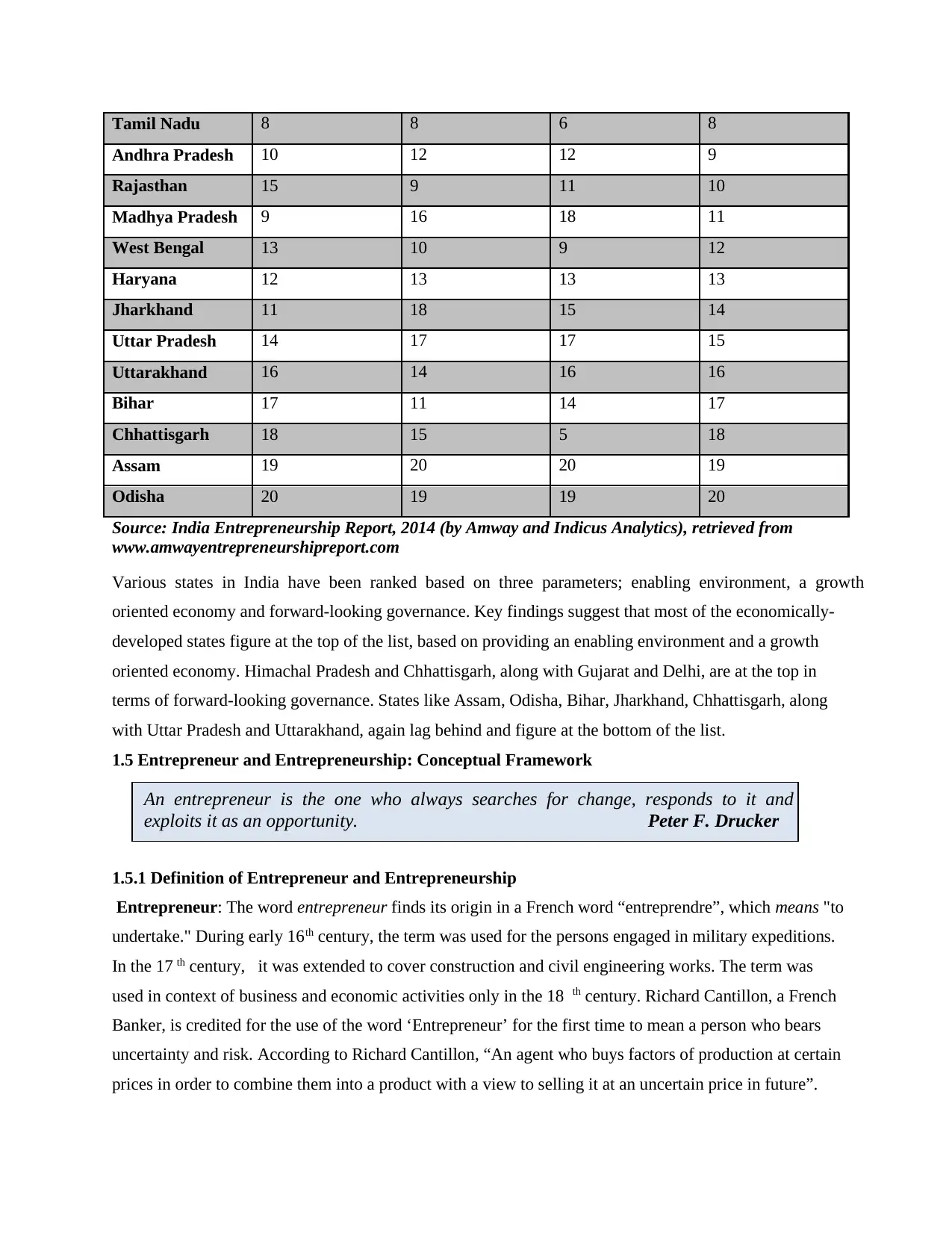
Tamil Nadu 8 8 6 8
Andhra Pradesh 10 12 12 9
Rajasthan 15 9 11 10
Madhya Pradesh 9 16 18 11
West Bengal 13 10 9 12
Haryana 12 13 13 13
Jharkhand 11 18 15 14
Uttar Pradesh 14 17 17 15
Uttarakhand 16 14 16 16
Bihar 17 11 14 17
Chhattisgarh 18 15 5 18
Assam 19 20 20 19
Odisha 20 19 19 20
Source: India Entrepreneurship Report, 2014 (by Amway and Indicus Analytics), retrieved from
www.amwayentrepreneurshipreport.com
Various states in India have been ranked based on three parameters; enabling environment, a growth
oriented economy and forward-looking governance. Key findings suggest that most of the economically-
developed states figure at the top of the list, based on providing an enabling environment and a growth
oriented economy. Himachal Pradesh and Chhattisgarh, along with Gujarat and Delhi, are at the top in
terms of forward-looking governance. States like Assam, Odisha, Bihar, Jharkhand, Chhattisgarh, along
with Uttar Pradesh and Uttarakhand, again lag behind and figure at the bottom of the list.
1.5 Entrepreneur and Entrepreneurship: Conceptual Framework
1.5.1 Definition of Entrepreneur and Entrepreneurship
Entrepreneur: The word entrepreneur finds its origin in a French word “entreprendre”, which means "to
undertake." During early 16th century, the term was used for the persons engaged in military expeditions.
In the 17 th century, it was extended to cover construction and civil engineering works. The term was
used in context of business and economic activities only in the 18 th century. Richard Cantillon, a French
Banker, is credited for the use of the word ‘Entrepreneur’ for the first time to mean a person who bears
uncertainty and risk. According to Richard Cantillon, “An agent who buys factors of production at certain
prices in order to combine them into a product with a view to selling it at an uncertain price in future”.
An entrepreneur is the one who always searches for change, responds to it and
exploits it as an opportunity. Peter F. Drucker
Andhra Pradesh 10 12 12 9
Rajasthan 15 9 11 10
Madhya Pradesh 9 16 18 11
West Bengal 13 10 9 12
Haryana 12 13 13 13
Jharkhand 11 18 15 14
Uttar Pradesh 14 17 17 15
Uttarakhand 16 14 16 16
Bihar 17 11 14 17
Chhattisgarh 18 15 5 18
Assam 19 20 20 19
Odisha 20 19 19 20
Source: India Entrepreneurship Report, 2014 (by Amway and Indicus Analytics), retrieved from
www.amwayentrepreneurshipreport.com
Various states in India have been ranked based on three parameters; enabling environment, a growth
oriented economy and forward-looking governance. Key findings suggest that most of the economically-
developed states figure at the top of the list, based on providing an enabling environment and a growth
oriented economy. Himachal Pradesh and Chhattisgarh, along with Gujarat and Delhi, are at the top in
terms of forward-looking governance. States like Assam, Odisha, Bihar, Jharkhand, Chhattisgarh, along
with Uttar Pradesh and Uttarakhand, again lag behind and figure at the bottom of the list.
1.5 Entrepreneur and Entrepreneurship: Conceptual Framework
1.5.1 Definition of Entrepreneur and Entrepreneurship
Entrepreneur: The word entrepreneur finds its origin in a French word “entreprendre”, which means "to
undertake." During early 16th century, the term was used for the persons engaged in military expeditions.
In the 17 th century, it was extended to cover construction and civil engineering works. The term was
used in context of business and economic activities only in the 18 th century. Richard Cantillon, a French
Banker, is credited for the use of the word ‘Entrepreneur’ for the first time to mean a person who bears
uncertainty and risk. According to Richard Cantillon, “An agent who buys factors of production at certain
prices in order to combine them into a product with a view to selling it at an uncertain price in future”.
An entrepreneur is the one who always searches for change, responds to it and
exploits it as an opportunity. Peter F. Drucker
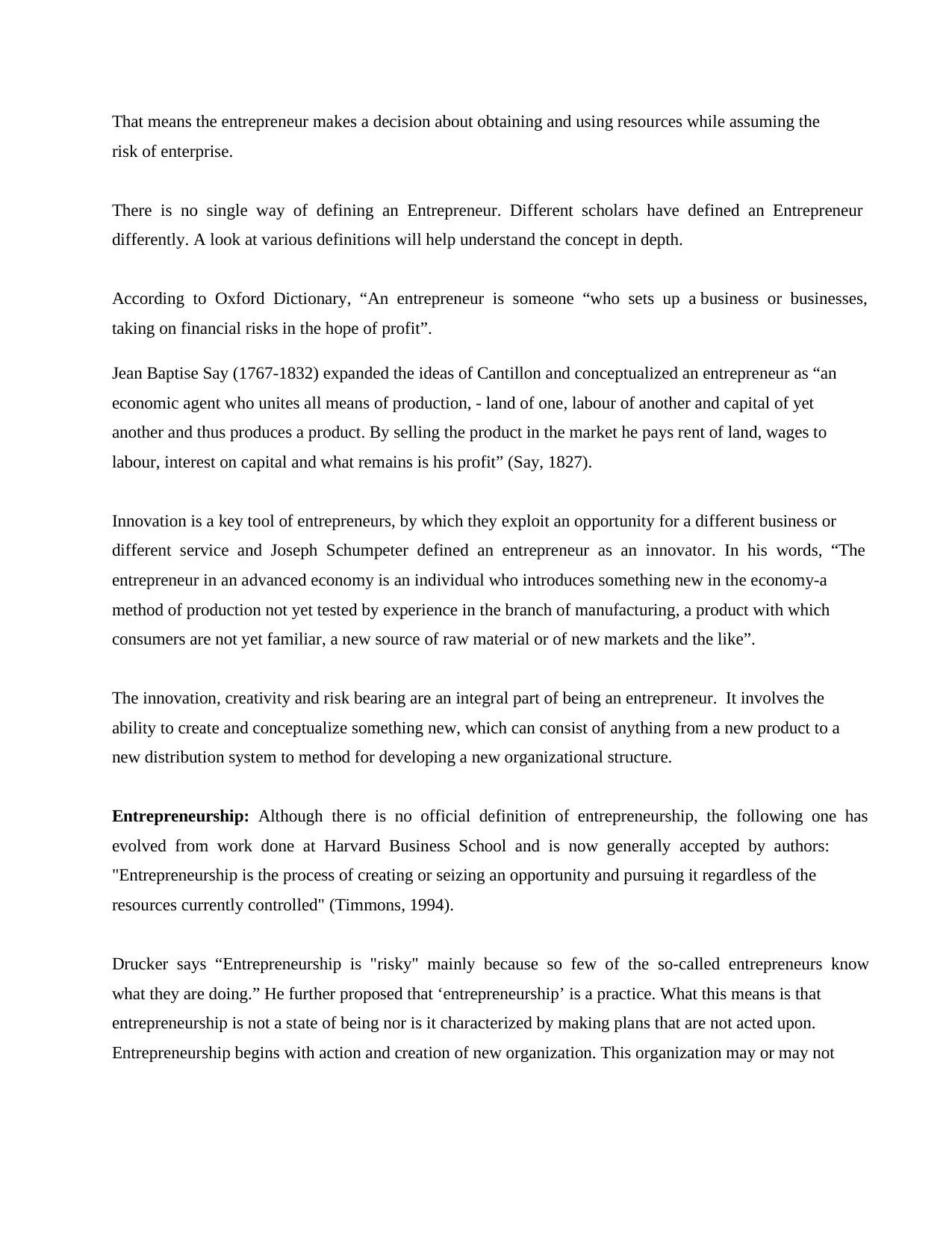
That means the entrepreneur makes a decision about obtaining and using resources while assuming the
risk of enterprise.
There is no single way of defining an Entrepreneur. Different scholars have defined an Entrepreneur
differently. A look at various definitions will help understand the concept in depth.
According to Oxford Dictionary, “An entrepreneur is someone “who sets up a business or businesses,
taking on financial risks in the hope of profit”.
Jean Baptise Say (1767-1832) expanded the ideas of Cantillon and conceptualized an entrepreneur as “an
economic agent who unites all means of production, - land of one, labour of another and capital of yet
another and thus produces a product. By selling the product in the market he pays rent of land, wages to
labour, interest on capital and what remains is his profit” (Say, 1827).
Innovation is a key tool of entrepreneurs, by which they exploit an opportunity for a different business or
different service and Joseph Schumpeter defined an entrepreneur as an innovator. In his words, “The
entrepreneur in an advanced economy is an individual who introduces something new in the economy-a
method of production not yet tested by experience in the branch of manufacturing, a product with which
consumers are not yet familiar, a new source of raw material or of new markets and the like”.
The innovation, creativity and risk bearing are an integral part of being an entrepreneur. It involves the
ability to create and conceptualize something new, which can consist of anything from a new product to a
new distribution system to method for developing a new organizational structure.
Entrepreneurship: Although there is no official definition of entrepreneurship, the following one has
evolved from work done at Harvard Business School and is now generally accepted by authors:
"Entrepreneurship is the process of creating or seizing an opportunity and pursuing it regardless of the
resources currently controlled" (Timmons, 1994).
Drucker says “Entrepreneurship is "risky" mainly because so few of the so-called entrepreneurs know
what they are doing.” He further proposed that ‘entrepreneurship’ is a practice. What this means is that
entrepreneurship is not a state of being nor is it characterized by making plans that are not acted upon.
Entrepreneurship begins with action and creation of new organization. This organization may or may not
risk of enterprise.
There is no single way of defining an Entrepreneur. Different scholars have defined an Entrepreneur
differently. A look at various definitions will help understand the concept in depth.
According to Oxford Dictionary, “An entrepreneur is someone “who sets up a business or businesses,
taking on financial risks in the hope of profit”.
Jean Baptise Say (1767-1832) expanded the ideas of Cantillon and conceptualized an entrepreneur as “an
economic agent who unites all means of production, - land of one, labour of another and capital of yet
another and thus produces a product. By selling the product in the market he pays rent of land, wages to
labour, interest on capital and what remains is his profit” (Say, 1827).
Innovation is a key tool of entrepreneurs, by which they exploit an opportunity for a different business or
different service and Joseph Schumpeter defined an entrepreneur as an innovator. In his words, “The
entrepreneur in an advanced economy is an individual who introduces something new in the economy-a
method of production not yet tested by experience in the branch of manufacturing, a product with which
consumers are not yet familiar, a new source of raw material or of new markets and the like”.
The innovation, creativity and risk bearing are an integral part of being an entrepreneur. It involves the
ability to create and conceptualize something new, which can consist of anything from a new product to a
new distribution system to method for developing a new organizational structure.
Entrepreneurship: Although there is no official definition of entrepreneurship, the following one has
evolved from work done at Harvard Business School and is now generally accepted by authors:
"Entrepreneurship is the process of creating or seizing an opportunity and pursuing it regardless of the
resources currently controlled" (Timmons, 1994).
Drucker says “Entrepreneurship is "risky" mainly because so few of the so-called entrepreneurs know
what they are doing.” He further proposed that ‘entrepreneurship’ is a practice. What this means is that
entrepreneurship is not a state of being nor is it characterized by making plans that are not acted upon.
Entrepreneurship begins with action and creation of new organization. This organization may or may not
⊘ This is a preview!⊘
Do you want full access?
Subscribe today to unlock all pages.

Trusted by 1+ million students worldwide
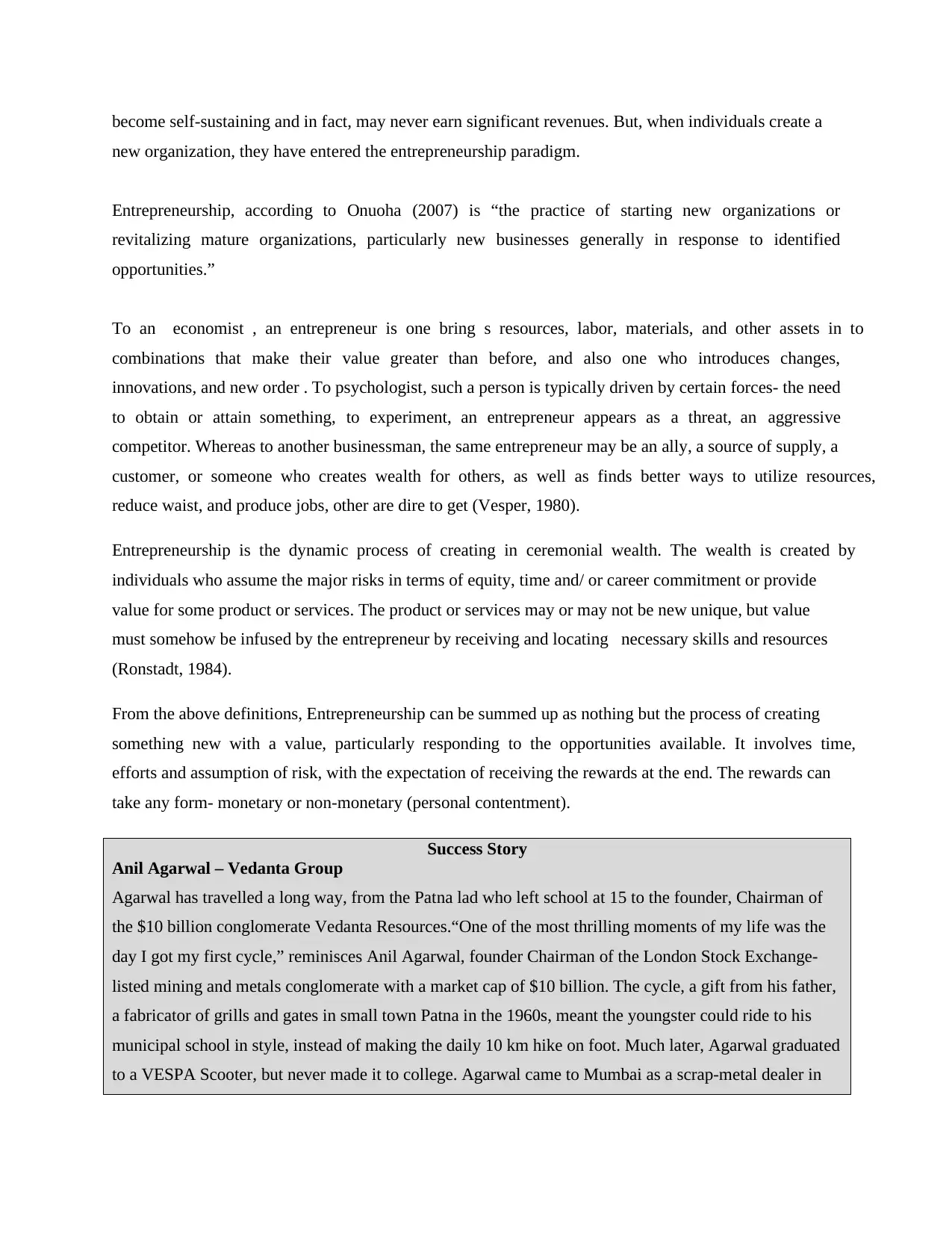
become self-sustaining and in fact, may never earn significant revenues. But, when individuals create a
new organization, they have entered the entrepreneurship paradigm.
Entrepreneurship, according to Onuoha (2007) is “the practice of starting new organizations or
revitalizing mature organizations, particularly new businesses generally in response to identified
opportunities.”
To an economist , an entrepreneur is one bring s resources, labor, materials, and other assets in to
combinations that make their value greater than before, and also one who introduces changes,
innovations, and new order . To psychologist, such a person is typically driven by certain forces- the need
to obtain or attain something, to experiment, an entrepreneur appears as a threat, an aggressive
competitor. Whereas to another businessman, the same entrepreneur may be an ally, a source of supply, a
customer, or someone who creates wealth for others, as well as finds better ways to utilize resources,
reduce waist, and produce jobs, other are dire to get (Vesper, 1980).
Entrepreneurship is the dynamic process of creating in ceremonial wealth. The wealth is created by
individuals who assume the major risks in terms of equity, time and/ or career commitment or provide
value for some product or services. The product or services may or may not be new unique, but value
must somehow be infused by the entrepreneur by receiving and locating necessary skills and resources
(Ronstadt, 1984).
From the above definitions, Entrepreneurship can be summed up as nothing but the process of creating
something new with a value, particularly responding to the opportunities available. It involves time,
efforts and assumption of risk, with the expectation of receiving the rewards at the end. The rewards can
take any form- monetary or non-monetary (personal contentment).
Success Story
Anil Agarwal – Vedanta Group
Agarwal has travelled a long way, from the Patna lad who left school at 15 to the founder, Chairman of
the $10 billion conglomerate Vedanta Resources.“One of the most thrilling moments of my life was the
day I got my first cycle,” reminisces Anil Agarwal, founder Chairman of the London Stock Exchange-
listed mining and metals conglomerate with a market cap of $10 billion. The cycle, a gift from his father,
a fabricator of grills and gates in small town Patna in the 1960s, meant the youngster could ride to his
municipal school in style, instead of making the daily 10 km hike on foot. Much later, Agarwal graduated
to a VESPA Scooter, but never made it to college. Agarwal came to Mumbai as a scrap-metal dealer in
new organization, they have entered the entrepreneurship paradigm.
Entrepreneurship, according to Onuoha (2007) is “the practice of starting new organizations or
revitalizing mature organizations, particularly new businesses generally in response to identified
opportunities.”
To an economist , an entrepreneur is one bring s resources, labor, materials, and other assets in to
combinations that make their value greater than before, and also one who introduces changes,
innovations, and new order . To psychologist, such a person is typically driven by certain forces- the need
to obtain or attain something, to experiment, an entrepreneur appears as a threat, an aggressive
competitor. Whereas to another businessman, the same entrepreneur may be an ally, a source of supply, a
customer, or someone who creates wealth for others, as well as finds better ways to utilize resources,
reduce waist, and produce jobs, other are dire to get (Vesper, 1980).
Entrepreneurship is the dynamic process of creating in ceremonial wealth. The wealth is created by
individuals who assume the major risks in terms of equity, time and/ or career commitment or provide
value for some product or services. The product or services may or may not be new unique, but value
must somehow be infused by the entrepreneur by receiving and locating necessary skills and resources
(Ronstadt, 1984).
From the above definitions, Entrepreneurship can be summed up as nothing but the process of creating
something new with a value, particularly responding to the opportunities available. It involves time,
efforts and assumption of risk, with the expectation of receiving the rewards at the end. The rewards can
take any form- monetary or non-monetary (personal contentment).
Success Story
Anil Agarwal – Vedanta Group
Agarwal has travelled a long way, from the Patna lad who left school at 15 to the founder, Chairman of
the $10 billion conglomerate Vedanta Resources.“One of the most thrilling moments of my life was the
day I got my first cycle,” reminisces Anil Agarwal, founder Chairman of the London Stock Exchange-
listed mining and metals conglomerate with a market cap of $10 billion. The cycle, a gift from his father,
a fabricator of grills and gates in small town Patna in the 1960s, meant the youngster could ride to his
municipal school in style, instead of making the daily 10 km hike on foot. Much later, Agarwal graduated
to a VESPA Scooter, but never made it to college. Agarwal came to Mumbai as a scrap-metal dealer in
Paraphrase This Document
Need a fresh take? Get an instant paraphrase of this document with our AI Paraphraser

1976, going on to build an empire in copper, zinc, aluminum and iron ore, recently venturing into power
generation. Vedanta Resources was the only Indian group to go for a primary listing on the London Stock
Exchange in 2003 and its subsidiary, Sterlite Industries, was listed on NYSE in 2007 in the largest IPO in
the US by an Indian company. The tipping point came in 2003. Frustrated with the license raj regime and
the constraints of raising capital in India, Agarwal had earlier moved to London. From a British
newspaper he learnt that Brian Gilbertson, the South African dealmaker who engineered the $57 billion
takeover of BHP by Billiton in 2001 to create the world’s largest mining group, had fallen out with the
merged leadership. So Agarwal made a cold call, just like that: “I always take a chance. I told Gilbertson
that I would like him to help me list my company.” In turn, Gilbertson asked about his hobbies, and
Agarwal recollects, “I told him that my hobbies are whatever the other man wants. Gilbertson said, ‘I do
cycling.’ I replied, ‘I do cycling too’.” The pair biked 60 km from Oxford to London, with Agarwal
trailing. Agarwal reflects, Some strength helped me cover that distance. Gilbertson came to India, checked
out all our assets and was impressed. I offered him a good package and he became Chairman.” Vedanta
subsequently attracted others on the board—P. Chidambaram, the late Sir David Gore-Booth and Michael
Fowle, Chairman, KPMG—and the company successfully listed on the London Stock Exchange. With
this, Agarwal became a global player in mining and metals in less than a decade.
When Agarwal came to Mumbai for the first time as a 20-year-old, he was fascinated by Narendra Desai,
Chairman, Apar Group, the doyen of the aluminum industry at that time. Thirty years later, the two still
meet over a cup of tea every week and share a bond that transcends business. Agarwal says, “He is a
follower of the Hare Krishna movement. From him I learnt that you can be an industrialist and also be a
bhakt.” In 1993, Ranjit Pandit, now Managing Director, General Atlantic, had just moved back to Mumbai
from New York, to open McKinsey and Co.’s India practice, which he chaired. In inimitable Agarwal
style, Pandit got a call out of the blue, with Agarwal describing Sterlite as a small company which had a
lot to learn. From then on, Pandit has been a regular sounding board. He says: “Look at the power
generation company he’s going to list. It has just 1,000MW, but he’s growing it to 10,000MW, and his
valuation is based on that”. The person who has perhaps most influenced Agarwal’s recent thinking is an
American, Steve Elbaum, Chairman, Superior Cables, inspired Agarwal’s 2006 $1 billion pledge to set up
the Vedanta University, a world-class university, on a 3,200 ha site in Orissa. Says Agarwal: “I want to
spend 20% of my time on philanthropy, building lasting institutions the way American industrialists have
done. That’s my passion now”. His critics say the real motivation is Vedanta’s interests in Orissa, which
holds the world’s fourth largest bauxite deposits—the mining of these has been opposed by some
environmentalists and tribals, resulting in Norway’s Government Pension Fund divesting its small holding
in Vedanta.
Source: Mallya, L.S. (2011) Successful Entrepreneurs: A Case Study of Indian Origin, PhD Thesis, Dr.
generation. Vedanta Resources was the only Indian group to go for a primary listing on the London Stock
Exchange in 2003 and its subsidiary, Sterlite Industries, was listed on NYSE in 2007 in the largest IPO in
the US by an Indian company. The tipping point came in 2003. Frustrated with the license raj regime and
the constraints of raising capital in India, Agarwal had earlier moved to London. From a British
newspaper he learnt that Brian Gilbertson, the South African dealmaker who engineered the $57 billion
takeover of BHP by Billiton in 2001 to create the world’s largest mining group, had fallen out with the
merged leadership. So Agarwal made a cold call, just like that: “I always take a chance. I told Gilbertson
that I would like him to help me list my company.” In turn, Gilbertson asked about his hobbies, and
Agarwal recollects, “I told him that my hobbies are whatever the other man wants. Gilbertson said, ‘I do
cycling.’ I replied, ‘I do cycling too’.” The pair biked 60 km from Oxford to London, with Agarwal
trailing. Agarwal reflects, Some strength helped me cover that distance. Gilbertson came to India, checked
out all our assets and was impressed. I offered him a good package and he became Chairman.” Vedanta
subsequently attracted others on the board—P. Chidambaram, the late Sir David Gore-Booth and Michael
Fowle, Chairman, KPMG—and the company successfully listed on the London Stock Exchange. With
this, Agarwal became a global player in mining and metals in less than a decade.
When Agarwal came to Mumbai for the first time as a 20-year-old, he was fascinated by Narendra Desai,
Chairman, Apar Group, the doyen of the aluminum industry at that time. Thirty years later, the two still
meet over a cup of tea every week and share a bond that transcends business. Agarwal says, “He is a
follower of the Hare Krishna movement. From him I learnt that you can be an industrialist and also be a
bhakt.” In 1993, Ranjit Pandit, now Managing Director, General Atlantic, had just moved back to Mumbai
from New York, to open McKinsey and Co.’s India practice, which he chaired. In inimitable Agarwal
style, Pandit got a call out of the blue, with Agarwal describing Sterlite as a small company which had a
lot to learn. From then on, Pandit has been a regular sounding board. He says: “Look at the power
generation company he’s going to list. It has just 1,000MW, but he’s growing it to 10,000MW, and his
valuation is based on that”. The person who has perhaps most influenced Agarwal’s recent thinking is an
American, Steve Elbaum, Chairman, Superior Cables, inspired Agarwal’s 2006 $1 billion pledge to set up
the Vedanta University, a world-class university, on a 3,200 ha site in Orissa. Says Agarwal: “I want to
spend 20% of my time on philanthropy, building lasting institutions the way American industrialists have
done. That’s my passion now”. His critics say the real motivation is Vedanta’s interests in Orissa, which
holds the world’s fourth largest bauxite deposits—the mining of these has been opposed by some
environmentalists and tribals, resulting in Norway’s Government Pension Fund divesting its small holding
in Vedanta.
Source: Mallya, L.S. (2011) Successful Entrepreneurs: A Case Study of Indian Origin, PhD Thesis, Dr.
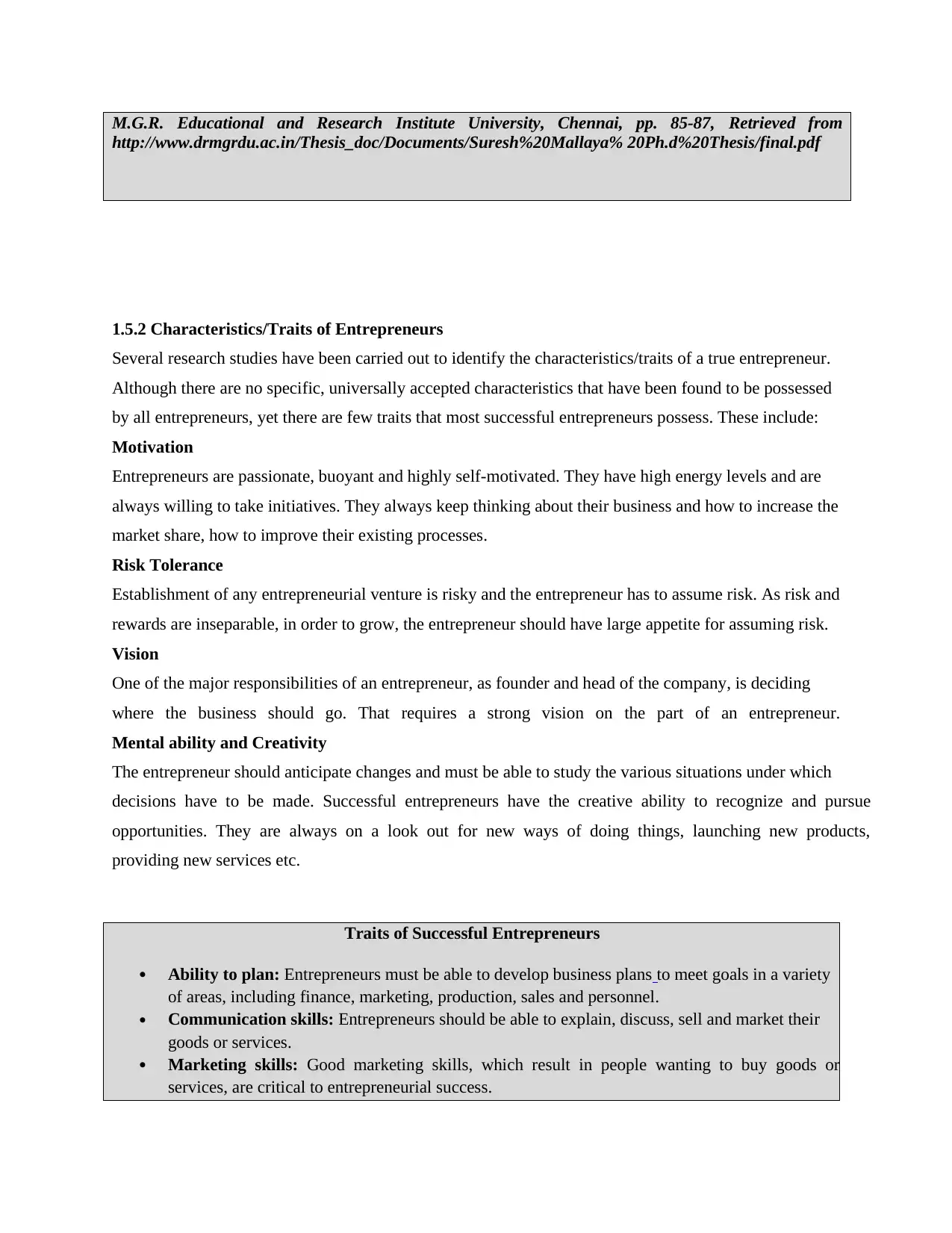
M.G.R. Educational and Research Institute University, Chennai, pp. 85-87, Retrieved from
http://www.drmgrdu.ac.in/Thesis_doc/Documents/Suresh%20Mallaya% 20Ph.d%20Thesis/final.pdf
1.5.2 Characteristics/Traits of Entrepreneurs
Several research studies have been carried out to identify the characteristics/traits of a true entrepreneur.
Although there are no specific, universally accepted characteristics that have been found to be possessed
by all entrepreneurs, yet there are few traits that most successful entrepreneurs possess. These include:
Motivation
Entrepreneurs are passionate, buoyant and highly self-motivated. They have high energy levels and are
always willing to take initiatives. They always keep thinking about their business and how to increase the
market share, how to improve their existing processes.
Risk Tolerance
Establishment of any entrepreneurial venture is risky and the entrepreneur has to assume risk. As risk and
rewards are inseparable, in order to grow, the entrepreneur should have large appetite for assuming risk.
Vision
One of the major responsibilities of an entrepreneur, as founder and head of the company, is deciding
where the business should go. That requires a strong vision on the part of an entrepreneur.
Mental ability and Creativity
The entrepreneur should anticipate changes and must be able to study the various situations under which
decisions have to be made. Successful entrepreneurs have the creative ability to recognize and pursue
opportunities. They are always on a look out for new ways of doing things, launching new products,
providing new services etc.
Traits of Successful Entrepreneurs
Ability to plan: Entrepreneurs must be able to develop business plans to meet goals in a variety
of areas, including finance, marketing, production, sales and personnel.
Communication skills: Entrepreneurs should be able to explain, discuss, sell and market their
goods or services.
Marketing skills: Good marketing skills, which result in people wanting to buy goods or
services, are critical to entrepreneurial success.
http://www.drmgrdu.ac.in/Thesis_doc/Documents/Suresh%20Mallaya% 20Ph.d%20Thesis/final.pdf
1.5.2 Characteristics/Traits of Entrepreneurs
Several research studies have been carried out to identify the characteristics/traits of a true entrepreneur.
Although there are no specific, universally accepted characteristics that have been found to be possessed
by all entrepreneurs, yet there are few traits that most successful entrepreneurs possess. These include:
Motivation
Entrepreneurs are passionate, buoyant and highly self-motivated. They have high energy levels and are
always willing to take initiatives. They always keep thinking about their business and how to increase the
market share, how to improve their existing processes.
Risk Tolerance
Establishment of any entrepreneurial venture is risky and the entrepreneur has to assume risk. As risk and
rewards are inseparable, in order to grow, the entrepreneur should have large appetite for assuming risk.
Vision
One of the major responsibilities of an entrepreneur, as founder and head of the company, is deciding
where the business should go. That requires a strong vision on the part of an entrepreneur.
Mental ability and Creativity
The entrepreneur should anticipate changes and must be able to study the various situations under which
decisions have to be made. Successful entrepreneurs have the creative ability to recognize and pursue
opportunities. They are always on a look out for new ways of doing things, launching new products,
providing new services etc.
Traits of Successful Entrepreneurs
Ability to plan: Entrepreneurs must be able to develop business plans to meet goals in a variety
of areas, including finance, marketing, production, sales and personnel.
Communication skills: Entrepreneurs should be able to explain, discuss, sell and market their
goods or services.
Marketing skills: Good marketing skills, which result in people wanting to buy goods or
services, are critical to entrepreneurial success.
⊘ This is a preview!⊘
Do you want full access?
Subscribe today to unlock all pages.

Trusted by 1+ million students worldwide
1 out of 41
Your All-in-One AI-Powered Toolkit for Academic Success.
+13062052269
info@desklib.com
Available 24*7 on WhatsApp / Email
![[object Object]](/_next/static/media/star-bottom.7253800d.svg)
Unlock your academic potential
Copyright © 2020–2025 A2Z Services. All Rights Reserved. Developed and managed by ZUCOL.